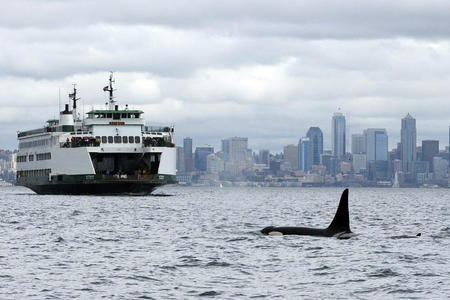Scientists have known since the 1980s that beluga whales’ sharp senses can pick up boat noise from up to 80 kilometers away. But this noise is much more than a nuisance—it can divert belugas away from feeding, nursing, or resting grounds, cause stress, and interfere with their ability to hear each other and perceive important information about their environments, like how deep the water is or where to locate prey. In a new study, scientists led by Morgan Martin, a zoologist at the University of Victoria in British Columbia and the Wildlife Conservation Society Canada, reveal in unprecedented detail how belugas will flee, dive, and otherwise rush to escape the distressing din.
In 2018, a group of scientists with Fisheries and Oceans Canada got permission from the Inuvialuit Game Council to tag eight male beluga whales with GPS trackers and time-depth monitors, which log where a beluga is in the water column every second. When Martin was handed the data set, she was excited to find that the loggers yielded “unbelievably cool, precise, beautiful tracks” as the whales swam around the eastern Beaufort Sea. “We could see exactly what depth they were diving to and how long they were down there,” she says.
By looking at these 3D whale tracks side by side with ships’ locations, which were broadcast by the vessels’ onboard automatic identification system transponders, Martin and her colleagues modeled and mapped the recorded encounters between belugas and ships. They also created animations of each interaction.
The belugas’ most common reaction to a loud noise, they found, was to abruptly change direction. Sometimes the whale would circle back once the ship had passed to continue on its journey.
In other cases, a beluga confronted with a noisy ship would make a sharp V-shaped dive, descending and ascending quickly rather than staying submerged as it typically would when foraging. Other times, the whales would dive just below the surface and hightail it away from the noise. If a beluga was already swimming away from a ship, it wouldn’t change its heading, but the study shows that the whale would swim faster than average when a ship was within its hearing range.
Valeria Vergara, a marine mammal scientist at the Raincoast Conservation Foundation who wasn’t involved in the research, says the study’s findings reaffirm just how sensitive belugas are to noise.
Sound is the main way many marine animals communicate and understand their environments. When a noisy boat goes by, Vergara says, the sound completely shuts down or masks belugas’ vocalizations and can lead to chronic stress. Not only that, but swimming an extra 50 kilometers off course to avoid the noise uses up energy that is especially precious in the freezing Arctic.
“When we’re talking about [noise pollution in] really important habitats like feeding grounds or covering grounds or nursery areas, then you have a problem,” she says.
“Underwater noise,” says Martin, “is one of the most pervasive forms of pollution.” But unlike an oil spill, which can linger for years or more, noise pollution, she says, is “a form of pollution that’s completely, absolutely eradicable if you just remove the source of it.”
To help beluga whales, she says, ships need to be made quieter. More than that, she adds, policymakers need to consider setting up marine protected areas and quiet sanctuaries in key beluga habitat.
This story was produced for Hakai Magazine on Oct. 31, 2022 and is republished here with permission.





